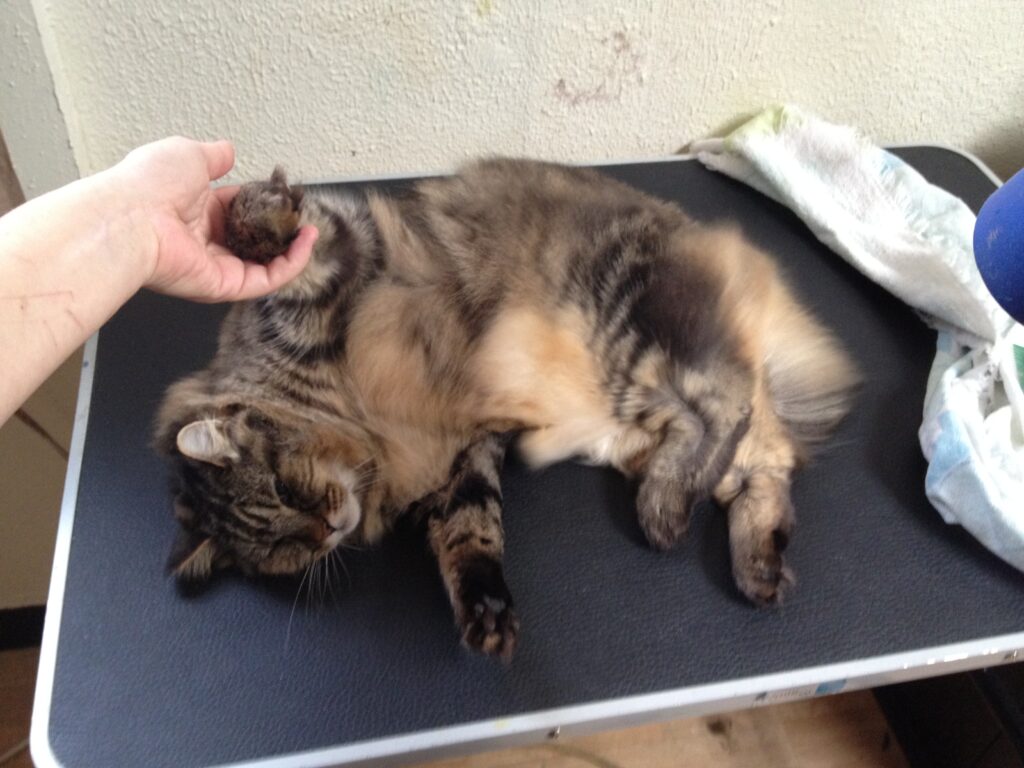I’m always met with raised eyebrows when I explain what I do for a living. It seems there are many “myths” being perpetuated about cat grooming that aren’t entirely true. I’d like to help dispel some of these myths for you.
* CATS GROOM THEMSELVES – Cats lick themselves. If you licked yourself all over, would you consider yourself clean? When cats “groom” themselves, they are performing multiple functions: removing dead hair, dandruff, sebum (naturally occurring oils produced by sebaceous glands in a cats skin), and sometimes even feces. And we wonder why they throw up hairballs?
*CATS HATE WATER – I’ve heard countless stories of owners being scratched and bitten while trying to put their feisty felines in the tub. I’ve even seen videos of it on Youtube. Most of them make me cringe. If introduced properly, either at an early age or in the right environment with the right techniques, most cats can adjust very well. I have groomed well over 400 cats in the last 3 years, and only one or two didn’t handle it well. Many of my clients’ phone calls start out with “my cat has never been bathed before,” to which I reply, “There is a first time for everything.”
In my experience, I find that if the cat isn’t going to like part of the process, it’s going to be the drying. There are 2 options when it comes to drying a cat: cage drying or using a high velocity dryer. Think of this as a small leaf blower that uses pinpoint air pressure to force the dead hair from a cat’s skin. While this is the best option, it can be a little bit frightening because of the noise it can make. If this happens, I recommend a combination of the 2 types of drying techniques. Unless the cat is a single-coated, Oriental-type breed, it must be dried properly and fully. The dead cat fur can actually form a type of tight bond when mixed with water— resulting in matting—if the cat has an excessive amount of dead hair, dandruff, or sebum.
Matting is not only unsightly; it can also be quite painful. The hair is tightly bonded and slowly pulls live hairs out of the skin along with dead hairs. If the area of matting is too large or tight, trying to de-matt the cat can also pull live hairs out by the roots, thus inhibiting hair re-growth. If a cat is matted, the most humane treatment is to shave the matted area and just to start fresh. Sometimes, this is just a small area; sometimes it’s the entire cat. Many think that the cat will be embarrassed by shaving, but I can’t tell you how many of my clients have called back to say “my cat has been acting 10 years younger since its haircut.”
*ALL CATS NEED TO BE SEDATED FOR GROOMING –Every time an animal goes under sedation, there is a risk. In the right environment and in the hands of an experienced groomer, most cats can be groomed quite easily. Although some cats, and even some dogs, may have severe episodes of aggression or anxiety that require sedation for grooming, this should be reserved for only the most severe cases and should only be administered under veterinary guidance.
There are all sorts of reasons for cats to be professionally groomed. For cat lovers who also crave a meticulous house, grooming reduces shedding, dandruff, and hairballs. For older cats suffering from inflammation of the gums or arthritis, grooming substitutes for elderly cats’ decreasing ability to care for themselves. Obese cats may not be able to reach certain areas of their bodies to lick them. Some cats are just poor groomers and will not allow their owners to groom them.
In my experience, a clean cat is a happy cat. Sometimes, cats just need a little help. Unless you have an extensive knowledge of cats, a multitude of costly cat grooming tools including specialized dryers, and a pair of chainmail gloves, you and your cat will both benefit from the services of a professional groomer.
So, how do you find a cat groomer? The internet is a great place to start. Then, call and ask the groomer questions about their services and facilities. Some grooming shops will not groom cats. Others will groom cats right alongside dogs. Some grooming shops have “cat only” hours or days, while a few exclusively groom cats. You need to decide what environment would be the most comfortable for your cat and what services will benefit you and your cat the most.



